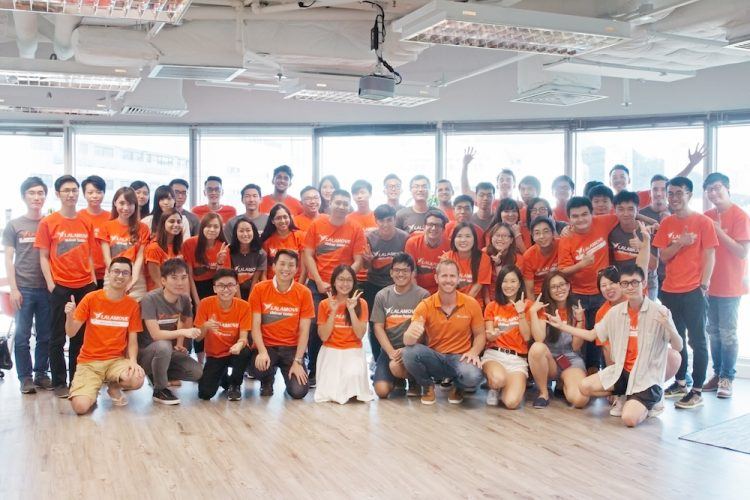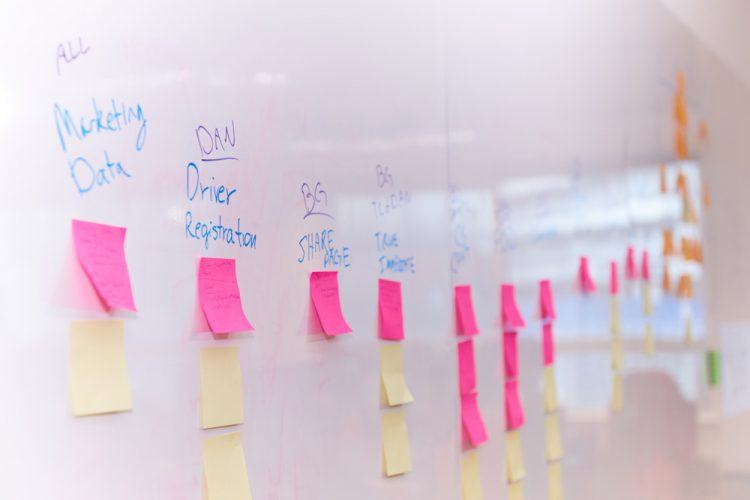
The Lalamove team / Photo credit: Lalamove
Founded as EasyVan in 2013, Hong Kong-based Lalamove set out with a vision of making on-demand local deliveries faster and easier. In a little under five years, the logistics startup has raised $160 million, employs 1,500 employees worldwide, and has a presence in 100 cities. It’s on track to be Hong Kong’s next unicorn, closely following Gogovan, a market competitor from the same island-city.
With Lalamove rapidly expanding, I was interested to find out how the engineering team keeps up. I spoke to Lalamove’s tech team lead, Chen Sun.
Lalamove’s engineering team

Chen (far right) pictured with some of the company’s engineers / Photo credit: Lalamove
The engineering team at Lalamove comprises six separate teams: three feature teams, two system optimization teams, and one infrastructure team.
The feature teams work on the universal app, the driver app, and the web app. The system optimization teams improve the backend and foundation of the system, while the infrastructure team handles system stability to prevent crashes.
Engineers rotate teams every few months so work remains fresh.
Team structure
The engineering team at Lalamove has about 35 people, with around three to eight people per sub-team. Each sub-team has a tech lead who provides leadership, mentorship, and guidance. The tech leads report to the company’s chief technology officer (CTO).
On top of having engineers, a product manager (PM) is attached to almost every engineering team. Product requests come from the PM, who is considered a member of the product team. All PMs at Lalamove have technical backgrounds.
Take Chen’s team, for instance. Chen leads the system optimization team at Lalamove. His team consists of six people, five of which – including Chen – are backend engineers. The sixth member is a quality assurance engineer. A PM is also attached to Chen’s team.
Here’s an example of what the team does. Previously, Lalamove’s system could only support one city per country. This year, the service will be made available in more than one city in some countries. In the Philippines, for example, Lalamove will be in both Manila and Cebu. Drivers from Manila might drive over to Cebu and vice versa. Chen’s team needed to make sure that such cases are supported by the system.
Apart from optimizing the system, Chen’s team also creates APIs for the company’s business users like Burger King and Ikea, which tap on Lalamove’s technology to support their delivery needs. A majority of Lalamove’s revenue comes from these business users.
Product development process

Photo credit: Lalamove
Generally, the product development process looks like this:
Hypothesis -> Validate hypothesis -> Build prototype -> Measure success -> Build product -> Iterate
The product development process begins with the product team, which regularly reviews a list of potential features gathered from user feedback and business needs. It then comes up with a hypothesis of what needs to be done. If it’s a new feature or product, the team will speak to users to ensure that there’s a demand for it. If there is, then these features or products will be distilled into a series of tasks for the engineering team.
Next, the product and engineering teams meet to discuss the long-term plan for each of the tasks and proritize them. Afterward, leaders of the tech teams are called to a hand-off meeting, where tasks will be assigned to the respective teams.
The teams will then set off to work on their assigned tasks. They start by analyzing problems with the current system, gathering metrics, and designing potential solutions. Once a working prototype is ready, the team will test it in a sandbox environment, gather metrics for it, and compare the data with that of the current system. Adjustments are then made at this stage to fit the initial design goals.
Once the feature reaches a satisfactory state of maturity, it is rolled out to users.
The team will monitor the released feature to gauge its success based on its initial success metrics. This will help them better understand its impact on users.
Further iterations of the feature or product will take place at this stage.
Once settled, the teams then look for new or existing features to tackle, and the product development cycle begins anew.
Challenges

Photo credit: Lalamove
The mid-stage startup is looking to scale by over 10 times in the next 12 months, and the greatest challenge for the engineering team is to keep up with that growth. The team is overcoming this with backend revamps and system optimizations.
One improvement that Chen would like to make is setting up a better system aimed at training junior engineers to step up to lead projects.
“Our business is growing very quickly, at about four to five times per year,” says Chen. “This means that each engineer will also have to grow by four to five times, and we need to provide a lot of training for that.”
At present, Lalamove has a training program in place where every team lead will be assigned to a team lead trainee. While under mentorship, trainees can go for technical presentations organized by team leads as well as get a chance to manage the team and develop leadership skills.
Chen would like to see a more structured and efficient system in place that can take care of junior hires from onboarding to becoming a project leader.
Hiring

Photo credit: Lalamove
The hiring process at Lalamove begins with a screening by the recruiter. If selected, candidates meet the hiring manager. The next round is a three to five-hour take-home technical challenge: once completed, it’s turned over to tech leads for review and feedback. Finally, successful candidates meet up with the executive team, including the CTO, over a meal.
This helps ensure that every employee shares Lalamove’s core values – that they are passionate, gritty, humble, and skilled in execution.
Besides having strong coding skills and a sense of responsibility, one of the most important characteristics the team looks out for is proactivity.
“Our ideal employee can not only translate business requirements into code but is also willing to actively seek out pain points in our products and solve them,” says Chen.
This post How this $160m Hong Kong startup runs its engineering team appeared first on Tech in Asia.
from Tech in Asia https://www.techinasia.com/160m-hong-kong-startup-runs-engineering-team
via IFTTT

No comments:
Post a Comment